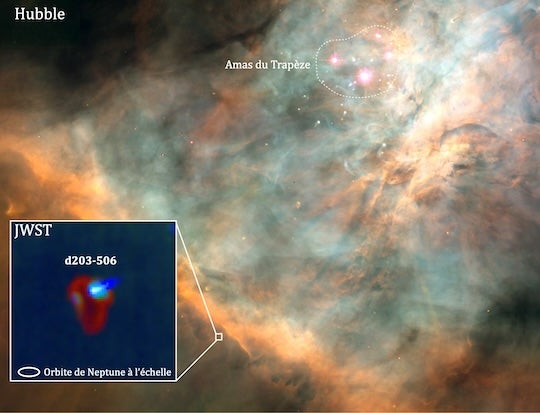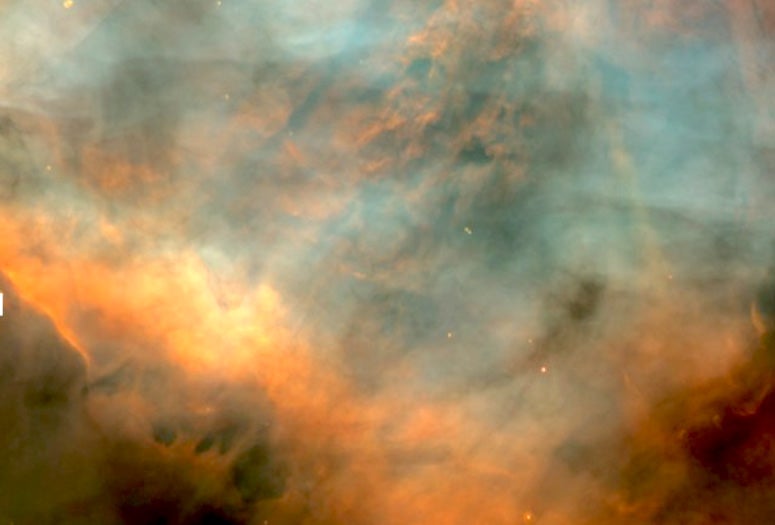NASA has released the first stunning images of the Orion Nebula from the James Webb Space Telescope in a study in the journal Science that shows with unprecedented precision how massive stars impact the formation of planetary systems.

The international research team includes Rice University astronomer Patrick Hartigan and was led by Olivier Berné, a research scientist in astrophysics at France’s National Center for Scientific Research.
“This work is important because it explores how radiation from nearby massive stars affects solar systems and stars,” Hartigan said. “Most stars and planets are born in these environments, where ultraviolet radiation may evaporate circumstellar disks before planets have enough time to fully form. In this project, the Webb telescope targeted a protostar located just outside the ionization front in the Orion Nebula. Ultraviolet radiation penetrating through the front to the protostar is responsible for photoevaporation in the disk.”
Observations of the protoplanetary disk d203-506 helped researchers learn that massive stars ⎯ 10 times more massive than the sun and 100,000 times more luminous ⎯ emit intense ultraviolet radiation that either helps planets assemble or otherwise disperses their matter, preventing them from forming.
“By combining tracers of molecular hydrogen observed by Webb with direct observations of the disk using the Atacama Large Millimeter Array, the team could accurately estimate the rate of mass lost by such a system,” Hartigan said. “The results imply that the disk should evaporate within about a million years, significantly shorter than the time required to form planets fully. Hence, radiation will reduce the masses of the planets that might otherwise be born around these young stars. The results have implications for the distribution of planetary masses throughout our galaxy.”
Hartigan, a professor of physics and astronomy, is leading another James Webb Space Telescope project that is investigating a highly collimated supersonic jet from a protostar.
- Peer-reviewed paper:
-
A far-ultraviolet-driven photoevaporation flow observed in a protoplanetary disk | Science | DOI: 10.1126/science.adh2861
Authors: Olivier Berné, Emilie Habart, Els Peeters, Ilane Schroetter, Amelie Canin, Ameek Sidhu, Ryan Chown, Emeric Bron, Thomas J. Haworth, Pamela Klaassen, Boris Trahin, Dries Van De Putte, Felipe Alarcon, Marion Zannese, Alain Abergel, Edwin A. Bergin, Jeronimo Bernard-Salas, Christiaan Boersma, Jan Cami, Sara Cuadrado, Emmanuel Dartois, Daniel Dicken, Meriem El-Yajouri, Asuncion Fuente, Javier R. Goicoechea, Karl D. Gordon, Lina Issa, Christine Joblin, Olga Kannavou, Baria Khan, Ozan Lacinbala, David Languignon, Romane Le Gal, Alexandros Maragkoudakis, Raphael Meshaka, Yoko Okada, Takashi Onaka, Sofia Pasquini, Marc W. Pound, Massimo Robberto, Markus Rollig, Bethany Schefter, Thiebaut Schirmer, Thomas Simmer, Benoit Tabone, Alexander G. G. M. Tielens, S´ılvia Vicente, Mark G. Wolfire and PDRs4All team.
https://www.science.org/doi/10.1126/science.adh2861 - Image downloads:
-
https://news-network.rice.edu/news/files/2024/02/JWST-BERNE_Optical-and-near-infared-images-of-the-Orion-Bar-region-0ffa617705bf5867.jpg
CAPTION: Hubble image of the Orion Nebula and a zoom in on the protoplanetary disc d203-506 taken with the James Webb Space Telescope. (Credit: NASA/STScl/Rice U./C O’Dell et al/O. Berné, I. Schrotter, PDRs4All)
- Links:
-
Wiess School of Natural Sciences:https://naturalsciences.rice.edu/
Department of Physics and Astronomy:https://physics.rice.edu/
Patrick Hartigan website: https://sparky.rice.edu/~hartigan/

